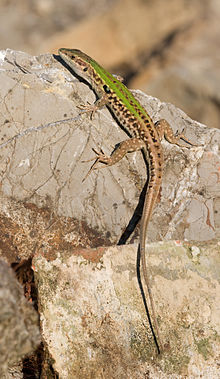- Italian wall lizard
-
- Common names:Italian wall lizard, İstanbul lizard
Italian wall lizard 
Conservation status Scientific classification Kingdom: Animalia Phylum: Chordata Class: Reptilia Order: Squamata Family: Lacertidae Genus: Podarcis Species: P. sicula Binomial name Podarcis sicula
(Rafinesque, 1810)Synonyms Podarcis siculus
(Rafinesque, 1810)The Italian wall lizard or Ruin lizard (Podarcis sicula) is a species of lizard in the Lacertidae family. P. sicula is native to Bosnia and Herzegovina, Croatia, France, Italy, Serbia and Montenegro, Slovenia and Switzerland, but has also been introduced to Spain, Turkey, and the United States.[1] P. sicula belongs to the Lacertidae family of lizards and it is the most abundant lizard species in southern Italy.[2]
P. sicula gained attention in 2008 following the publication of a research study[3] that detailed distinct morphological and behavioral changes in a P. sicula population indicative of "rapid evolution".[4][5][6][7][8]
Contents
Habitat
Its natural habitats are temperate forests, temperate shrubland, Mediterranean-type shrubby vegetation, temperate grassland, rocky areas, rocky shores, sandy shores, arable land, pastureland, plantations, rural gardens, and urban areas.[1]
Sub-species
P. sicula contains dozens of subspecies.[9] The current distribution patterns of the subspecies have been interpreted as the consequence of natural events, including regional glacial refuges and postglacial area expansions, and multiple introductions by man.[10]
Rapid evolution
In 1971, ten adult P. sicula specimens from the island of Pod Kopište were transported 3.5 km east to the island of Pod Mrčaru (both Croatian islands lie in the Adriatic Sea near Lastovo), where they founded a new bottlenecked population.[3][11] The two islands have similar size, elevation, microclimate, and a general absence of terrestrial predators[11] and the P. sicula expanded for decades without human interference, even outcompeting the (now extinct[3]) local Podarcis melisellensis population.[4]
Following the Yugoslav Wars, scientists returned to Pod Mrčaru and found that the lizards currently occupying Pod Mrčaru differ greatly from those on Pod Kopište. While mitochondrial DNA analyses have verified that P. sicula currently on Pod Mrčaru are genetically indistinguishable from the Pod Kopište source population,[3] the new Pod Mrčaru population of P. sicula was described, in August 2007, as having a larger average size, shorter hind limbs, lower maximal sprint speed and altered response to simulated predatory attacks compared to the original Pod Kopište population.[11] These population changes in morphology and behavior were attributed to "relaxed predation intensity" and greater protection from vegetation on Pod Mrčaru.[11]
In 2008, further analysis revealed that the Pod Mrčaru population of P. sicula have significantly different head morphology (longer, wider, and taller heads) and increased bite force compared to the original Pod Kopište population.[3] This change in head shape corresponded with a shift in diet: Pod Kopište P. sicula are primarily insectivorous, but those on Pod Mrčaru eat substantially more plant matter.[3] The changes in foraging style may have contributed to a greater population density and decreased territorial behavior of the Pod Mrčaru population.[3]
The most surprising[5] difference found between the two populations was the discovery, in the Pod Mrčaru lizards, of cecal valves, which slow down food passage and provide fermenting chambers, allowing commensal microorganisms to convert cellulose to nutrients digestible by the lizards.[3] Additionally, the researchers discovered that nematodes were common in the guts of Pod Mrčaru lizards, but absent from Pod Kopište P. sicula, which do not have cecal valves. The cecal valves, which occur in less than 1 percent of all known species of scaled reptiles,[5] have been described as an "evolutionary novelty, a brand new feature not present in the ancestral population and newly evolved in these lizards".[7]
Other research
P. sicula has served as an animal model for many areas of research, including investigations of circadian rhythms.[2][12]
See also
- List of reptiles of Italy
References
- ^ a b Isailovic, J.C., Vogrin, M., Corti, C., Mellado, V.P., Sá-Sousa, P., Cheylan, M. & Pleguezuelos, J. 2005. Podarcis sicula. 2006 IUCN Red List of Threatened Species. Downloaded on 28 July 2007.
- ^ a b De Falco M, Sciarrillo R, Virgilio F, et al. (August 2004). "Annual variations of adrenal gland hormones in the lizard Podarcis sicula". J. Comp. Physiol. A Neuroethol. Sens. Neural. Behav. Physiol. 190 (8): 675–81. doi:10.1007/s00359-004-0528-1. PMID 15170520.
- ^ a b c d e f g h Herrel A, Huyghe K, Vanhooydonck B, et al. (March 2008). "Rapid large-scale evolutionary divergence in morphology and performance associated with exploitation of a different dietary resource". Proc. Natl. Acad. Sci. U.S.A. 105 (12): 4792–5. doi:10.1073/pnas.0711998105. PMC 2290806. PMID 18344323. http://www.pubmedcentral.nih.gov/articlerender.fcgi?tool=pmcentrez&artid=2290806.
- ^ a b "National Geographic: Lizards Rapidly Evolve After Introduction to Island". http://news.nationalgeographic.com/news/2008/04/080421-lizard-evolution.html. Retrieved 2008-05-27.
- ^ a b c "UMass Amherst : In the Loop : Talking Points : Lizards undergo rapid evolution after introduction to new home, says researcher". http://www.umass.edu/loop/talkingpoints/articles/74409.php. Retrieved 2008-05-27.
- ^ "Science Daily: Lizards Undergo Rapid Evolution After Introduction To A New Home". http://www.sciencedaily.com/releases/2008/04/080417112433.htm. Retrieved 2008-05-27.
- ^ a b PZ Myers "Pharyngula: Still just a lizard". http://scienceblogs.com/pharyngula/2008/04/still_just_a_lizard.php. Retrieved 2008-05-27.
- ^ "Newswise: Lizards Undergo Rapid Evolution After Introduction to New Island". http://newswise.com/articles/view/539909/. Retrieved 2008-08-06.
- ^ "TYPICAL LIZARDS (Lacertidae): Podarcis sicula ssp". http://www.cyberlizard.plus.com/lacertids2s.htm. Retrieved 2008-06-02.
- ^ Podnar M, Mayer W, Tvrtković N (February 2005). "Phylogeography of the Italian wall lizard, Podarcis sicula, as revealed by mitochondrial DNA sequences". Mol. Ecol. 14 (2): 575–88. doi:10.1111/j.1365-294X.2005.02427.x. PMID 15660947.
- ^ a b c d Bart Vervust, Irena Grbac, Raoul Van Damme (August 2007). "Differences in morphology, performance and behaviour between recently diverged populations of Podarcis sicula mirror differences in predation pressure". Oikos 116 (8): 1343–1352. doi:10.1111/j.0030-1299.2007.15989.x.
- ^ Foá A, Bertolucci C (May 2003). "Toward a seasonal model of the circadian system: the case of Ruin lizards". Front. Biosci. 8: s236–42. doi:10.2741/1037. PMID 12700027. http://www.bioscience.org/2003/v8/s/1037/list.htm.
External links
Categories:- IUCN Red List least concern species
- Podarcis
Wikimedia Foundation. 2010.

